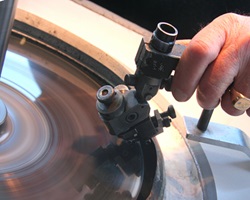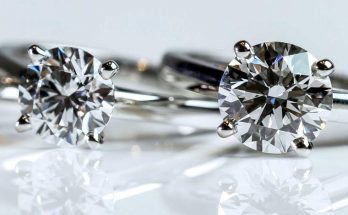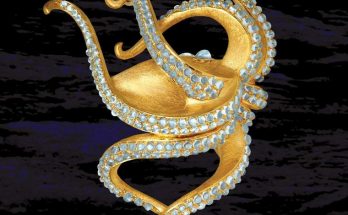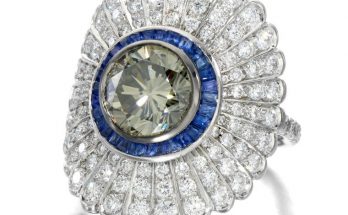Before we can talk about the reasons behind lower quality cuts, let’s take a look at the various factors we can measure the quality of a diamond with. Diamonds can be differentiated by their shape and four common characteristics, also known as the “four C’s” of diamonds: cut, clarity, color and carat.
Out of the 4Cs, cut is the factor that is decided by the actions of humans. It is also what determines if a diamond will sparkle with life or appear dull and lifeless. Obviously, who doesn’t want a diamond that looks brilliant and fiery?
Now, if all rough diamonds have the potential to be turned into beautiful jewels, why do diamond cutters polish rough stones to crappy proportions? And when you think about it, it’s kind of ironic because the cutters themselves will not buy a diamond that looks lifeless.
Principles of Diamond Cutting – Effects on Appearance
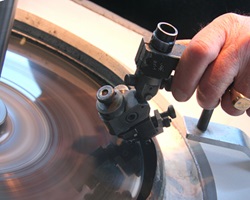
Dop And Tang Used in Polishing
Diamonds are unique because of their exceptional ability to reflect and refract light. Did you know that an ideally cut diamond reflects close to 100% of the light that enters it through the table and crown facets? This reflected light is seen as sparkle, fire and brilliance by the observer.
If a stone is cut too shallow, a fraction of light will leave the stone through the pavilion. Likewise, if a stone is cut too deep, a fraction of light will leave through its sides instead of being reflected back into the viewer’s eye as brilliance and sparkle. This is the reason why poorly cut diamonds often look darker and lack life.
Reasons Why Rough Stones Aren’t Cut to Maximize Light Performance
When we are talking about millions of dollars being involved with procuring rough diamonds, there won’t be much margin for errors in creating profitable end products. Contrary to popular belief, human errors aren’t responsible for poorly cut diamonds and there aren’t any impromptu decisions made on the polishing wheel.
You see, in the diamond business, the bottom line is to make money and rough stones are cut based on deliberate choices. In the cutting process, every rough stone is carefully analyzed and meticulously planned with the use of powerful computing systems.
When deciding how to cut a rough stone, economics and profitability are 2 factors that are always placed above cut quality. After all, a diamond’s price is most significantly affect by carat weight. And because of this reason, both cutters and retailers have strong financial incentives to retain weight in a rough diamond at the expense of having an inferior cut.
Example of How a Rough Diamond is Utilized
To illustrate this, let’s say we have a rough crystal that weighs 3.00 carats. From this rough, it is possible to attain two 1.3 carat round diamonds with a cut rating of “good” and these 2 diamonds have a total market value of $30,000.
It is also possible for the same rough crystal to be used to create 2 ideal cut stones weighing 1.00 carat and 0.90 carats instead. In contrast, these 2 diamonds could only sell for a total of $22,000 even though they have better optical performance.
Besides the higher market value the first option presents, the “good” cut diamonds are cheaper to produce because less time and skilled labor is needed on the polishing table. Logically speaking, which option would you take if you were the business owner?
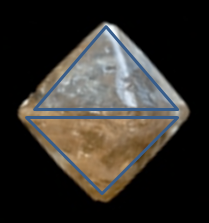
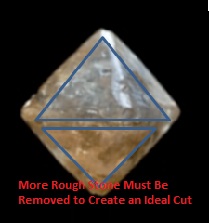
Most cutters maximize carat weight instead of “sacrificing” weight for better cut.
Other Factors to Consider When Cutting a Diamond
Sometimes, the cutter’s decisions are influenced by material flaws and the intrinsic shape of the rough diamond. For example, the location of inclusions in a rough can force cutters to polish the diamond in a particular manner such that the inclusions get removed.
Such decisions are usually made with the help of high-tech scanning equipment and visualization software. Ultimately, priority is always given to better sale-ability and overall value at the expense of cut quality.
Examples of Round Diamonds With Different Cut Grades
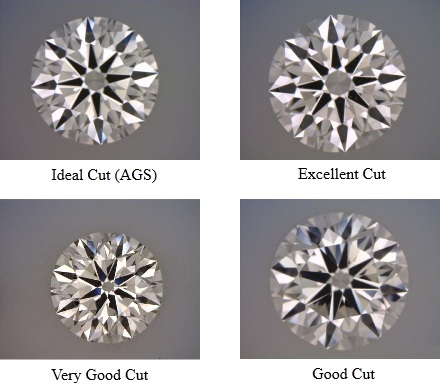
If you want an engagement ring that looks beautiful and you are on a budget, my advice for you is to compromise on aspects like color, clarity and carat weight. Never compromise on cut because it actually helps make up for each of these 3 aspects.
That said, I do know of people who intentionally sacrifice cut because they have a minimum requirement in carat weight they must meet. With a limited budget to work with, the only way for them to afford a larger diamond is to lower qualities of the other 3Cs – cut, color and clarity. I personally think that it is a bad idea to buy diamonds in this manner but the decision ultimately lies in your hands.
To wrap things up, here’s a video that shows various diamonds with excellent and very good cut ratings being compared side by side. Under the various lighting conditions, you can easily see why cut matters in a diamond’s appearance.
For a consumer, a reliable gemological report will offer you an accurate assessment about the diamond’s material properties and cut quality. On this note, I want to highlight that different labs (e.g. GIA and AGS) take a slightly different approach to evaluating cut quality. Since cut is such a major topic in the diamond selection process, I want discuss this is a topic in more depth on the next page…
<<
>>
SOURCE:http://beyond4cs.com/shapes/round/why-diamonds-are-not-cut-ideally/
